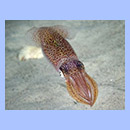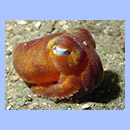Characteristics:
Cephalopods are mollusks, where the foot has developed into a set of arms or tentacles. Another common feature is their ability to squirt ink when threatened. Their body is symmetrical, i.e. the left and right side of the body is identical.
Most cephalopods rely on their well developed vision to detect their pray or potential enemies. They are even able to detect the polarization of the light. Surprisingly enough, most cephalopods are color blind, even if many of them have the ability to change colors according to the surroundings.
Cephalopods are regarded as the most intelligent invertebrates. They have a well developed brain in contrast to any other mollusk. The brain is large, compared to the body size, and the nervous system is very complex.
Taxonomy:
There are approximately 800 known living species, all marine, registered in the world today. On the other hand, ten times as many fossil species have been found, indicating that the Cephalopods had a more dominating position in the oceans some hundred million years ago, before the vertebrates invaded land and long before humans set foot on earth. They are believed to descend from simple, externally shelled mollusks. Living cephalopods are members of one of the following two infraclasses:
- Decapodiformes are all ten-armed and include cuttlefish (order Sepiida) and squids (Teuthida).
- Octopodiformes are eight-armed octupuses (Octopoda) and vampire squids (Vampyromorphida).


